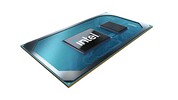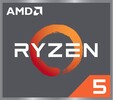Intel Core i5-1145G7 vs AMD Ryzen 5 3550H vs Intel Core i7-1185G7
Intel Core i5-1145G7
► remove from comparison
The Intel Core i5-1145G7 is a power efficient quad-core SoC for laptops and Ultrabooks based on the Tiger Lake-U generation that was announced early 2021. It integrates four Willow Cove processor cores (8 threads thanks to HyperThreading). The base clock speed depends on the TDP settings and ranges from 1.1 GHz (12 Watt TDP) up to 2.6 GHz (28 Watt). The Boost is always specified at 4.4 GHz (one or two cores).
Another novelty is the integrated Xe graphics card with 80 EUs based on the completely new Gen 12 architecture. It offers a significantly higher performance compared to the older Iris Plus G7 (Ice Lake).
Furthermore, Tiger Lake SoCs add PCIe 4 support (4 lanes), AI hardware acceleration, and the partial integration of Thunderbolt 4 / USB 4 and Wifi 6 in the chip. In addition to this, the i5 supports vPro for easy remote management.
The chip is produced on the improved 10nm SuperFin process at Intel that should be comparable to the 7nm process at TSMC (e.g. Ryzen 4000 series).
All articles on Tiger Lake can be found on our Tiger Lake architecture hub.
AMD Ryzen 5 3550H
► remove from comparison
The AMD Ryzen 5 3550H is a mobile SoC that was announced in January 2019. It combines four Zen+ cores (8 threads) clocked at 2.1 GHz to 3.7 GHz with a Radeon RX Vega 8 graphics adapter with 8 CUs (512 Shaders) clocked at up to 1,200 MHz. Compared to the similar Ryzen 5 3500U, the 3550H offers a 20 Watt higher TDP and therefore a better performance under long periods of load. The integrated dual-channel memory controller supports up to DDR4-2400 memory. As the features of the Picasso APUs are the same compared to the Raven Ridge predecessors, we point to our Raven Ridge launch article.
The Picasso SoCs use the Zen+ microarchitecture with slight improvements that should lead to a 3% IPS (performance per clock) improvements. Furthermore, the 12 nm process allows higher clock rates at similar power consumptions.
Performance
The average 3550H in our database proves to be a solid mid-range CPU, its multi-thread benchmark scores hovering close to those of the Intel Core i7-10710U and the Core i5-8257U. Which is a little slow for an H-class processor, as of late 2021, but still more than enough for the vast majority of apps and games, provided one is fine with having to wait a little longer than usual for that 4K video encoding job to get completed.
Thanks to its decent cooling solution and sufficiently high CPU power limits, the Pavilion Gaming 15-ec0002ng is among the fastest laptops powered by the 3550H that we know of. It can be more than 20% faster in CPU-bound workloads than the slowest system featuring the same chip in our database, as of August 2023.
Power consumption
This Ryzen 5 series chip has a default TDP (also known as the long-term power limit) of 35 W. Laptop makers are free to reduce that value significantly with 12 W being the minimum AMD-recommended value. Clock speeds and performance would take a hit as a result; either way, that's a little too high to allow for passively cooled designs.
Last but not the least, the AMD Ryzen 5 3550H is built with a 12 nm process for lower-than-average, as of mid 2023, energy efficiency.
Intel Core i7-1185G7
► remove from comparison
The Intel Core i7-1185G7 is a power-efficient quad-core SoC for laptops and Ultrabooks based on the Tiger Lake-U generation (UP3) that was introduced September 2020. It integrates four Willow Cove processor cores (8 threads thanks to Hyper-Threading). Each core can clock from 1.2 GHz (12 W base clock speed), 3 GHz (28 W base clock speed) to 4.8 GHz (single-core boost). All cores at once can clock at up to 4.3 GHz. At the time of announcement, the i7-1185G7 is the fastest model of the line-up. Since early 2021, the i7-1185G7 supports management features like vPro.
Another novelty is the integrated Iris Xe iGPU based on the completely new Gen 12 architecture. It should offer a significantly higher performance compared to the older Iris Plus G7 (Ice Lake). In the i7-1185G7 it uses 96 EUs and clocks between 400 - 1,350 MHz. The GPU and CPU can together use the 12 MB of L3 cache.
Furthermore, Tiger Lake SoCs add PCIe 4 support (four lanes), AI hardware acceleration, and the partial integration of Thunderbolt 4/USB 4 and Wi-Fi 6 in the chip.
Performance
The average 1185G7 in our database is just as fast as AMD's hexa-core Ryzen 5 4500U, as far as multi-thread benchmark scores are concerned. While the i7 is not the fastest Tiger Lake chip by any stretch of imagination, it's more than usable for your productivity and creative apps, with a bit of gaming possible as well.
Thanks to its decent cooling solution and a long-term CPU power limit of 55 W, the Stealth 15M A11SEK is among the fastest laptops powered by the 1185G7 that we know of. It can be almost twice as fast in CPU-bound workloads as the slowest system featuring the same chip in our database, as of August 2023.
Power consumption
This little Core i7 here has a default TDP of 12 W to 28 W, the expectation being that laptop manufacturers will go for a higher value in exchange for higher performance. Either way, that's a tad too high to allow for passively cooled designs.
The chip is manufactured on Intel's third-gen 10 nm process marketed as SuperFin for average, as of late 2022, energy efficiency.
| Model | Intel Core i5-1145G7 | AMD Ryzen 5 3550H | Intel Core i7-1185G7 | ||||||||||||||||||||||||||||||||||||||||||||||||||||||||||||||||||||||||||||||||||||||||
| Codename | Tiger Lake-UP3 | Picasso-U (Zen+) | Tiger Lake-UP3 | ||||||||||||||||||||||||||||||||||||||||||||||||||||||||||||||||||||||||||||||||||||||||
| Series | Intel Tiger Lake | AMD Picasso (Ryzen 3000 APU) | Intel Tiger Lake | ||||||||||||||||||||||||||||||||||||||||||||||||||||||||||||||||||||||||||||||||||||||||
| Series: Tiger Lake Tiger Lake-UP3 |
|
|
| ||||||||||||||||||||||||||||||||||||||||||||||||||||||||||||||||||||||||||||||||||||||||
| Clock | 2600 - 4400 MHz | 2100 - 3700 MHz | 3000 - 4800 MHz | ||||||||||||||||||||||||||||||||||||||||||||||||||||||||||||||||||||||||||||||||||||||||
| L1 Cache | 320 KB | 384 KB | 320 KB | ||||||||||||||||||||||||||||||||||||||||||||||||||||||||||||||||||||||||||||||||||||||||
| L2 Cache | 5 MB | 2 MB | 5 MB | ||||||||||||||||||||||||||||||||||||||||||||||||||||||||||||||||||||||||||||||||||||||||
| L3 Cache | 8 MB | 4 MB | 12 MB | ||||||||||||||||||||||||||||||||||||||||||||||||||||||||||||||||||||||||||||||||||||||||
| Cores / Threads | 4 / 8 | 4 / 8 | 4 / 8 | ||||||||||||||||||||||||||||||||||||||||||||||||||||||||||||||||||||||||||||||||||||||||
| TDP | 28 Watt | 35 Watt | 28 Watt | ||||||||||||||||||||||||||||||||||||||||||||||||||||||||||||||||||||||||||||||||||||||||
| Technology | 10 nm | 12 nm | 10 nm | ||||||||||||||||||||||||||||||||||||||||||||||||||||||||||||||||||||||||||||||||||||||||
| max. Temp. | 100 °C | 105 °C | 100 °C | ||||||||||||||||||||||||||||||||||||||||||||||||||||||||||||||||||||||||||||||||||||||||
| Socket | BGA1449 | FP5 | BGA1449 | ||||||||||||||||||||||||||||||||||||||||||||||||||||||||||||||||||||||||||||||||||||||||
| Features | DDR4-3200/LPDDR4x-4266 RAM, PCIe 4, 4 GT/s bus, DL Boost, GNA, vPro, MMX, SSE, SSE2, SSE3, SSSE3, SSE4.1, SSE4.2, AVX, AVX2, AVX-512, BMI2, ABM, FMA, ADX, VMX, SMX, SMEP, SMAP, EIST, TM1, TM2, HT, Turbo, SST, AES-NI, RDRAND, RDSEED, SHA, TME | DDR4-2400 RAM, PCIe 3, MMX (+), SSE, SSE2, SSE3, SSSE3, SSE4.1, SSE4.2, SSE4A, AES, AVX, AVX2, FMA3, SHA | DDR4-3200/LPDDR4x-4266 RAM, PCIe 4, 4 GT/s bus, DL Boost, GNA, MMX, SSE, SSE2, SSE3, SSSE3, SSE4.1, SSE4.2, AVX, AVX2, AVX-512, BMI2, ABM, FMA, ADX, VMX, SMX, SMEP, SMAP, EIST, TM1, TM2, HT, Turbo, SST, AES-NI, RDRAND, RDSEED, SHA, TME | ||||||||||||||||||||||||||||||||||||||||||||||||||||||||||||||||||||||||||||||||||||||||
| iGPU | Intel Iris Xe Graphics G7 80EUs (400 - 1300 MHz) | AMD Radeon RX Vega 8 (Ryzen 2000/3000) ( - 1200 MHz) | Intel Iris Xe Graphics G7 96EUs (400 - 1350 MHz) | ||||||||||||||||||||||||||||||||||||||||||||||||||||||||||||||||||||||||||||||||||||||||
| Architecture | x86 | x86 | x86 | ||||||||||||||||||||||||||||||||||||||||||||||||||||||||||||||||||||||||||||||||||||||||
| Announced | |||||||||||||||||||||||||||||||||||||||||||||||||||||||||||||||||||||||||||||||||||||||||||
| Manufacturer | ark.intel.com | www.amd.com | ark.intel.com | ||||||||||||||||||||||||||||||||||||||||||||||||||||||||||||||||||||||||||||||||||||||||
| Transistors | 4500 Million |
Benchmarks
Average Benchmarks Intel Core i5-1145G7 → 100% n=46
Average Benchmarks AMD Ryzen 5 3550H → 77% n=46
Average Benchmarks Intel Core i7-1185G7 → 107% n=46
* Smaller numbers mean a higher performance
1 This benchmark is not used for the average calculation












